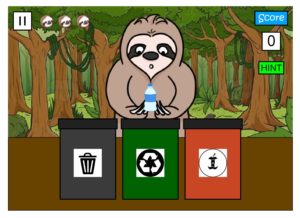For my final project, I set out to create a game that would teach people how to recycle. I think that at the end, I’m pretty satisfied with the outcome and feel that I’ve accomplished most of what I wanted to do. I think one of the things that was successful in the project was the serial communication between the “Arduino” and Processing, which itself took a week to figure out. I later went back and removed the motion sensor I had in there originally because it was too sensitive, and made do with three buttons instead. I also think I reached my goal of creating a game that was both educational and visually appealing, as I spent a lot of time on the visuals to make the game pop out more. However, there are also a lot of things that I wish I had more time to do, and would like to work on moving forward. One of them is a timer function, something like a 3, 2, 1, go mechanism at the start of the game, which was pretty complex and something I didn’t quite get to. I also would’ve liked to add audio, like the sounds of objects falling, movement, background noise, etc. as I think it would’ve added a lot to the experience. Another complicated feature I would’ve liked to add is a high score board where players can enter three characters “names” and have a total of maybe 5 high scores that would stay on the end screen, even after the game is closed.
Link to sketch on OpenProcessing (though it won’t work): https://www.openprocessing.org/sketch/546197
Documentation: documentation

